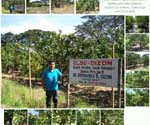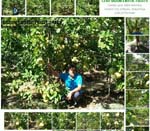|
|
|
Manila Bulletin, Agriculture,
Sunday, October 28, 2000 |
|
How to produce high quality
pummelo fruits |
|
Agri Plain
Talk by Zac B. Sarian |
|
|
PUMMELO,
particularly the right variety, will make a profitable crop
to grow in many parts of the country.
But why is it that there are no big plantation to speak of
in many parts of Luzon?
Part of the answer could be that there are no planting
materials of the good varieties readily available to
investors.
Another reason could be the fact that people who have tried
planting pummelo trees were not able to sustain their tree's
productivity for long periods. Bernie Dizon, the fruit
expert who graduated from the Central Luzon State University
and who has been doing personal research on pummelos, has
observed that many of the trees planted by some people is
due to the fact that the rootstocks used for budding is the
calamandarin.
When the trees have grown old, the calamandarin rootstock
will be too small to sustain the heavy growth of the pummelo,
he said. This results in the deterioration of the tree which
will eventually die.
Dizon also observes that when the point of union of the
budded tree is very low, the tree is susceptible to foot
rot.
In his long observation and actual experience in growing
pummelos, Dizon has observed that it is best to use native
pummelo seedlings as rootstocks for grafting. That is
exactly what he is doing in producing grafted Magallanes and
Nenita pummelos, two varieties with excellent eating quality
which he is propagating by thousands.
Aside from planting the right varieties, the application of
the right fertilizer at the right time is important. In the
beginning, when the trees are young, nitrogen and phosphorus
are important. Phosphorus, he explains, helps in the
production of an extensive root system.
When the trees are already of bearing age, it is important
to apply more potassium and trace elements. Trace elements
are the micronutrients such as boron, manganese, zinc, iron
and others. These, plus potassium, make the fruits sweet and
juicy (not dry)
What's good about pummelo is that they can be grown in many
parts of the country. They are low-growing, and more trees
can be grown in one hectare compared to mangoes. They can be
spaced five meters apart.
The fact that they are low-growing, they are not as
susceptible to damage by strong winds as the tall trees. The
fruits are also easier to protect from insects (rind borer)
by wrapping them with paper and perforated plastic bags
because the trees are not tall.
Pummelos also have the advantage of having a long
shelf-life. They could be kept for as long as one month
without spoiling. Hence, they can be transported to the
export market even by ship which is cheaper than by air.
This fruit is also known to be in demand in the foreign
markets. The is the reason why Thailand is converting even
many of its low-lying farms into pummelo plantations. They
create canals and dikes in their farms and plant the citrus
trees on the elevated dikes.
Dizon has also observed that it is beneficial to produce
pummelos with double rootstock. He has observed them to grow
faster and produce more fruits. Many of his mother trees at
the Central Luzon State University where he has a techno
demo farm have double rootstock. These trees produce two
crops a year.
He remembers a successful pummelo grower in Cabanatuan City,
several years back. The fellow had a very productive farm
where high quality fruits were harvested in commercial
quantities.
This means that to have a continuously productive orchard of
pummelo, one has to constantly maintain the trees. They have
to be fertilized and irrigated when necessary. They also
have to be protected from pests and disease, which are not
really difficult to do, according to Dizon. |
|
 |
|
CLSU-DIZON |
|
PROJECT |
 |
|
|

